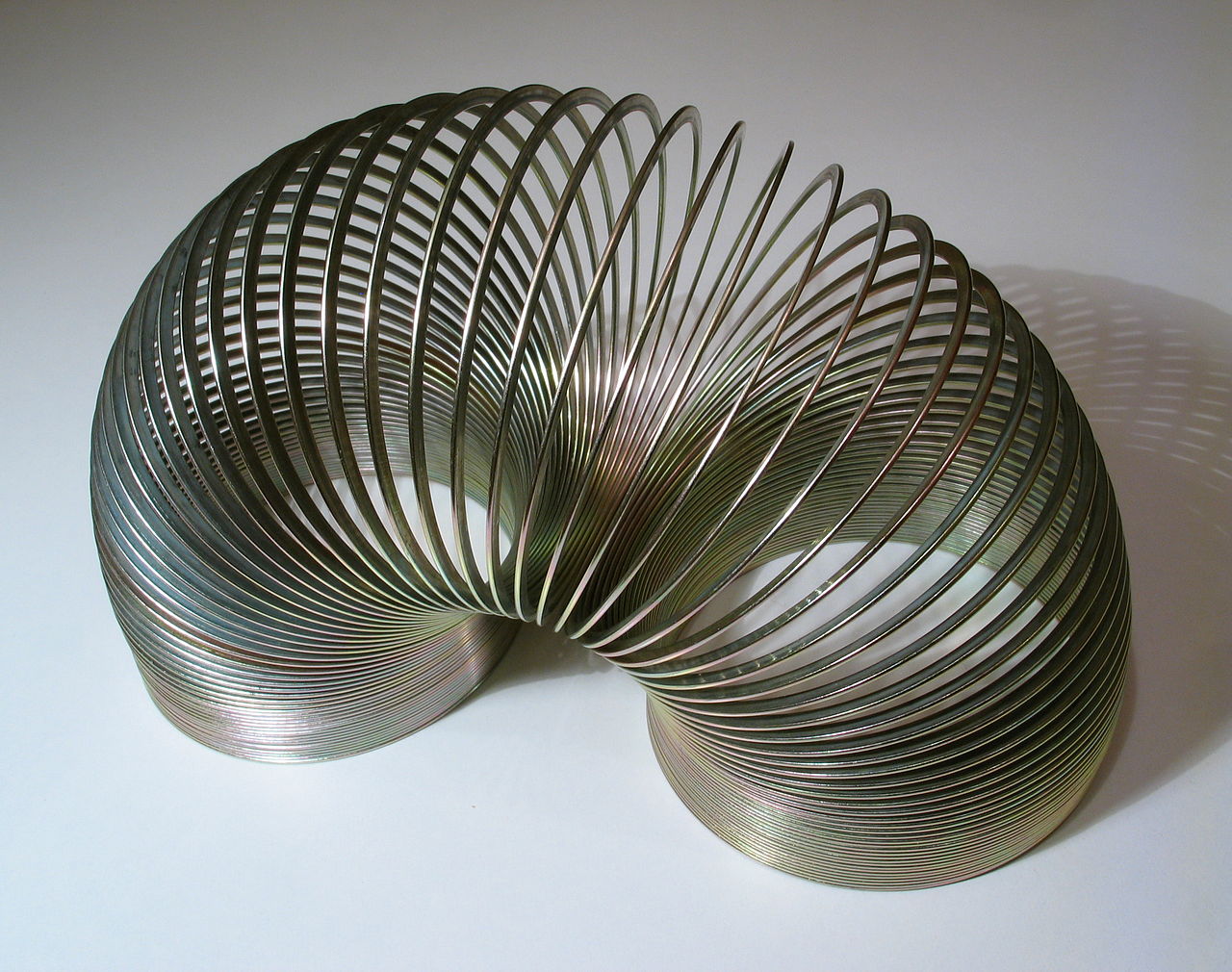![]() I’ve recently re-discovered the joy of the Slinky – one of the simplest of all children’s toys and yet so beguiling, as it seems to defy the laws of physics by hinting at some sort of perpetual motion.
I’ve recently re-discovered the joy of the Slinky – one of the simplest of all children’s toys and yet so beguiling, as it seems to defy the laws of physics by hinting at some sort of perpetual motion.
I happened across this old friend from my childhood when my Australian nephews were over for a visit and I found myself perusing the Guernsey toy shops looking for something to amuse them.
Whilst as a child I was prepared to accept that this is “just what slinkys did”, never giving a second thought to the physics of what was going on as it slinked its way down our stairs, as an adult I started wondering – how on earth does this work?
Origins
The Slinky was invented in wartime USA in 1943 by Richard James, a nautical engineer based in Philadelphia. James was working on trying to develop a means for suspending sensitive shipboard instruments in rough seas and it was whilst he was working with tension springs that serendipity took a hand when he accidentally dropped one. Amazed to see the spring travel onwards across the deck in incremental rolling jumps he immediately had an idea for a toy of some sort.
He went home and immediately set about experimenting with the helical design in order to work out the best dimensions along with experiments with various materials to see which it would work most smoothly with.
The design he came up with, which still endures to this day, was a coil of steel over 21m (69 ft) in length, with 98 loops of wire. When it went on sale in 1945 Richard and his wife were so worried that no one would buy it, because it was too simple, that they gave a close friend a dollar to buy one. However they needn’t have worried – an hour and a half after their first demonstration, they had sold a total of 400 Slinkys! Today it’s estimated that a quarter of a billion Slinkys are sold every year around the world.
Slinky Physics
Okay, so much for the origins but how does this metal marvel work?
Slinky Energy
My childhood mistake, when seeing this alive metal snake shimmying its way down the stairs, was in thinking the Slinky was conjuring energy out of nowhere. I wasn’t taking into account its ‘potential energy’ when it stood at the top of the stairs. That is the energy it had “stored away” by virtue of its raised position above the ground – what Physicists call “Potential Energy” – which can be released as it goes down the stairs, after being set in motion by a quick push.
The Slinky, like all objects, tends to resist change in its motion. Because of this inertia, when it’s placed at the top of the stairs it stays at rest without moving at all. At this point it has potential or stored energy. But once it is started down the stairs and gravity affects it, the potential energy is converted to the energy of motion or kinetic energy and the Slinky gracefully tumbles coil by coil down the stairs.
Slinky Movement
So we can see where it gets its energy from to do its ‘slinking’- but how does it slink?
It’s the physical properties of the slinky that determine how quickly (or if at all) it moves under the influence of gravity down the stairs. These physical properties come together in what is know as a spring constant.
Every spring, no matter the size, has a spring constant, which is a measure of not just how strong but also how long it is. It’s this spring constant that’s critical to get right in a Slinky, and to match it to the steps you are attempting to descend. If the spring constant is too high, the Slinky will flip itself down the steps and start falling rather than slinking. Too low, and when the top of the Slinky reaches the next step down, it gets stuck and doesn’t have enough pull to bring the bottom of the Slinky down as well. Similarly, if the size of the steps are wrong the Slinky won’t work. With very shallow steps, for example, most Slinkys will get stuck, as there is not enough room to pull the whole coil down to the next step.
Slinky Magic
 The Slinky magic occurs when you push the top of the Slinky over the edge of a step and onto the next step and the whole coil spools down onto the step lower down, then once on the lower step, the Slinky automatically starts again and descends to the next lower step, and so on – as we mentioned before, from a physics point of view, the potential energy is being released and converted into kinetic energy.
The Slinky magic occurs when you push the top of the Slinky over the edge of a step and onto the next step and the whole coil spools down onto the step lower down, then once on the lower step, the Slinky automatically starts again and descends to the next lower step, and so on – as we mentioned before, from a physics point of view, the potential energy is being released and converted into kinetic energy.
As the slinky moves down the steps, energy is transferred along its length in a longitudinal or compressional wave. How quickly the wave moves depends on the spring constant and the mass of the metal.
As the Slinky moves to a lower step, the last few coils of the Slinky do not join up with the rest of the coils and do not, even momentarily, come to a complete stop. The momentum of those last coils is able to overcome the force pulling them down onto the Slinky. Consequently, they flip over the top and start to fall down the next step via a transverse wave – ie a wave moving parallel to the stairs. Gravity then takes over and pulls this last bit of the Slinky coil , now moving parallel to the step down to the next lower step and the whole process begins again.
So there you are – Slinky Magic in a Nutshell





